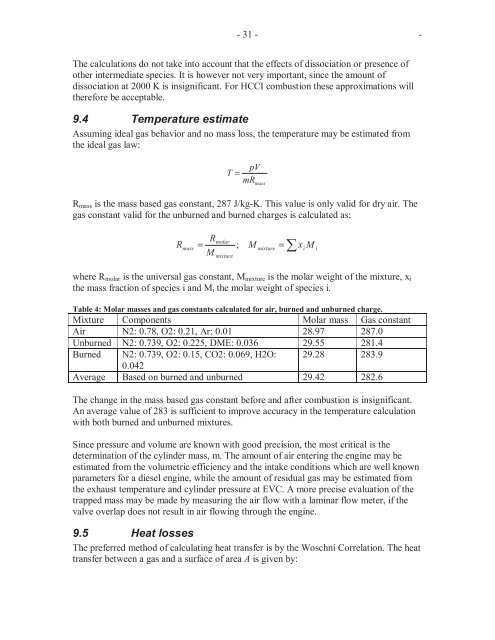Troels Dyhr Pedersen.indd - Solid Mechanics
Troels Dyhr Pedersen.indd - Solid Mechanics
Troels Dyhr Pedersen.indd - Solid Mechanics
Create successful ePaper yourself
Turn your PDF publications into a flip-book with our unique Google optimized e-Paper software.
- 31 - -<br />
The calculations do not take into account that the effects of dissociation or presence of<br />
other intermediate species. It is however not very important, since the amount of<br />
dissociation at 2000 K is insignificant. For HCCI combustion these approximations will<br />
therefore be acceptable.<br />
9.4 Temperature estimate<br />
Assuming ideal gas behavior and no mass loss, the temperature may be estimated from<br />
the ideal gas law:<br />
pV<br />
T =<br />
mRmass<br />
Rmass is the mass based gas constant, 287 J/kg-K. This value is only valid for dry air. The<br />
gas constant valid for the unburned and burned charges is calculated as:<br />
Rmolar<br />
R mass = ; M mixture = xi<br />
M i<br />
M<br />
mixture<br />
where Rmolar is the universal gas constant, Mmixture is the molar weight of the mixture, xi<br />
the mass fraction of species i and Mi the molar weight of species i.<br />
Table 4: Molar masses and gas constants calculated for air, burned and unburned charge.<br />
Mixture Components Molar mass Gas constant<br />
Air N2: 0.78, O2: 0.21, Ar: 0.01 28.97 287.0<br />
Unburned N2: 0.739, O2: 0.225, DME: 0.036 29.55 281.4<br />
Burned N2: 0.739, O2: 0.15, CO2: 0.069, H2O:<br />
0.042<br />
29.28 283.9<br />
Average Based on burned and unburned 29.42 282.6<br />
The change in the mass based gas constant before and after combustion is insignificant.<br />
An average value of 283 is sufficient to improve accuracy in the temperature calculation<br />
with both burned and unburned mixtures.<br />
Since pressure and volume are known with good precision, the most critical is the<br />
determination of the cylinder mass, m. The amount of air entering the engine may be<br />
estimated from the volumetric efficiency and the intake conditions which are well known<br />
parameters for a diesel engine, while the amount of residual gas may be estimated from<br />
the exhaust temperature and cylinder pressure at EVC. A more precise evaluation of the<br />
trapped mass may be made by measuring the air flow with a laminar flow meter, if the<br />
valve overlap does not result in air flowing through the engine.<br />
9.5 Heat losses<br />
The preferred method of calculating heat transfer is by the Woschni Correlation. The heat<br />
transfer between a gas and a surface of area A is given by:

















